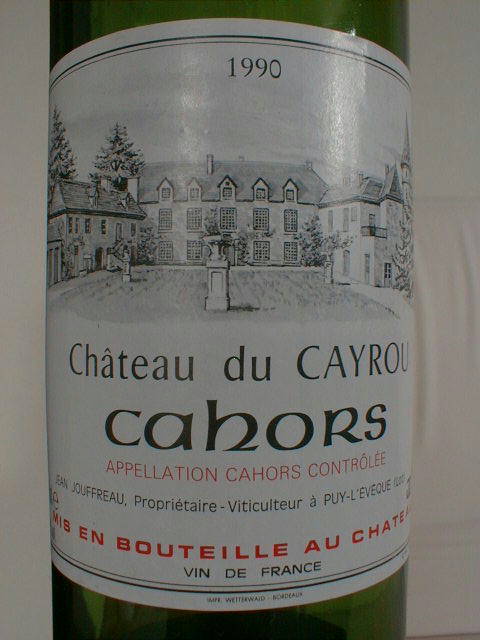
I
saw Lawrence Of Arabia when it came out in 1962, in the sort of grand
roadshow presentation big movies used to get back then — reserved
seating, an overture and intermission and an expensive souvenir program
on sale in the lobby (I still have mine.) My dad used to take me to
these big roadshow presentations of big films — it was one of the
great rituals of my childhood.
Lawrence blew me away back then, at the age of twelve. I saw it a few times
later and was less impressed. As an adult (and apprentice screenwriter)
I found the dialogue excessively literary and aphoristic — every line
was a bon mot, a philosophical nugget, an intellectual construction.
Real people, I thought, in real wars, don’t talk like that — even if
they’re Oxford-educated British officers or wise old Bedouin
chieftains.
Then I saw the restored version back in the Eighties, on a big screen, and
realized how wrong my second thoughts were. What I’d lost touch with
was the power of the images — the extent to which the images are the
story of this film, its narrative and its subtext, its spectacle and
its subtlety. The moment of revelation came watching the shot where
Lawrence walks along the top of the captured train. His Bedouin
followers run along the ground below him. In the shot, we only see
Lawrence’s shadow on the sand — his followers chase his shadow.
This is the whole film in a single image — the essence of the filmmaker’s
view that Lawrence both invented himself in Arabia and lost himself . .
. created an image that had no substance beyond the events it inspired,
yet cast a real shadow into the future. In the last shot, as Lawrence
is driven away from the scene of his betrayed triumph, we see his face
through the windshield of an open car. A reflection on the windshield
suddenly obliterates his face, and the film is over.
This is a mode of filmmaking — in which a film’s deepest truths are conveyed
by images alone — that characterized the silent era of cinema and which is
rarely seen today except in the theoretical film experiments of
Jean-Luc Godard. I began to see the dialogue of Lawrence in a
different light — as the functional equivalent of title cards, which
offered a kind of running literary commentary on or clarification of
the images but did not drive the narrative or the drama.
In short, I realized that Lawrence is essentially a silent film — in
the same sense that Titanic is essentially a silent film, a film
whose dialogue is virtually irrelevant to the actual meaning of the
work. Relatively unsophisticated twelve year-old boys and girls, for
whom the experience of a film is primarily visual and visceral, who
feel no intellectual need to translate a film into literary terms
before being able to appreciate it, have easier access to such
sound-era “silents”. They are, in this, sometimes wiser than their
elders.
Monthly Archives: January 2007
AMY CREHORE
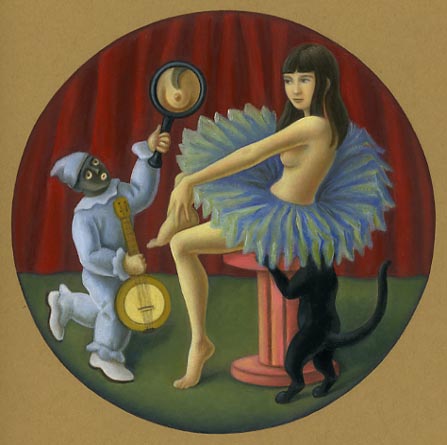
Check out the art of Amy Crehore, who makes delicious images that combine the sang-froid of Magritte with the innocence of antique vernacular icons and the insinuating eroticism of a high-class Parisian strip show from the Twenties:
She also has a blog filled with curious images and objects that clearly nourish her strange imagination, like the wondrous fruit crate label below:
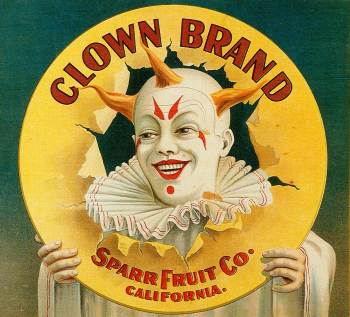
Her blog:
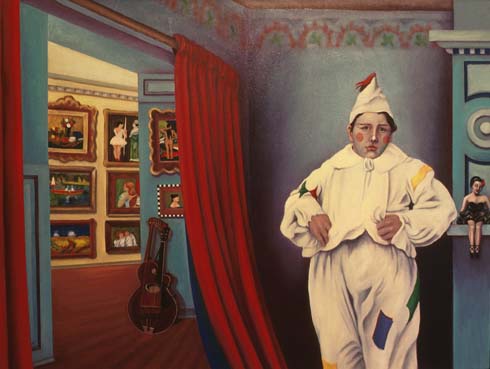
SUMURUN

In
Ernst Lubitsch's Sumurun, from 1920, Diaghilev's Ballets Russes meets
the Keystone Kops, and the result is an inspired piece of lunacy,
slight but very entertaining.
It's yet
another variation on the mood of silliness that seemed to grip Lubitsch
in the late Teens and early Twenties — a silliness that feels quite
un-Germanic. Edgar Ulmer said of Lubitsch that “he really should
have been a Frenchman,” but Lubitsch's silliness is not quite French,
either. When a Frenchman is being silly he'll always take care to
let you know how elegant his silliness is, how artful and
respectable. Lubitsch could certainly be elegant and artful, but
he was not above using vulgarity when it took his fancy. In the
early films at least he never seems to stand on his dignity, or his
genius — he strews his effects about like flower petals, or cow pies.
In this film,
we can see the two sources of Lubitsch's early style — the broad
comedy he specialized in as a cabaret performer and the more elegant
spectacle of the theater of Max Reinhardt, for whom Lubitsch did small
character roles. Sumurun is based on a Reinhardt pantomime, and
it's full of stylish (though silly) choreography and charming scenic
effects. Lubitsch himself plays the role of a grotesque clown in
love with a dancing girl in his troupe, and offers a few examples of
his eccentric dancing along with a bigger dose of his highly stylized
acting. His performance has been criticized for its exaggeration,
but I see a lot of art in it, and the theatricality doesn't seem out of
place amidst all the artificiality of the film as a whole.
Lubitsch doesn't seem to be taking himself too seriously, even when his
character is.
The narrative
feels disjointed and is hard to follow at times, probably because the
version that survives is missing about four reels cut by its American
distributor. It hardly matters, though, because the story is not
all that important — it's just an excuse for some pleasant diversion
in an Arabian Nights vein.
Pola Negri
plays the dancing girl mentioned above, and she's a real
revelation. I guess she's technically playing a vamp here, a
dancer who drives men mad, but she plays her with all the freshness and
spunk of a Kansas farm girl or Broadway hoofer. (She seduces the
Mighty Sheik with what look like cheerleading routines.) She
seems more like a flapper than an exotic femme fatale and she gives the
film a cheerful tone that matches Lubitsch's blithe approach to the
material. She must have been a breath of fresh air to film-goers
used to the ponderous dignity, and dignified poundage, of traditional
European divas.
CAULIFLOWER AND GRUYERE
How often do we take a moment from our busy lives to think about Gruyere? Not very often, I suspect. And yet it is a cheese of deep philosophical interest, simple, distinctive and useful.
There was a time when I thought of it only in connection with French onion soup, for without the Gruyere that’s melted on the piece of thick toast that floats on top of the soup, it is not French onion soup at all. It’s just brown stuff made out of onions.
I began thinking about Gruyere seriously and appropriately due to a chance remark by Mary Frances Kennedy Fisher, speaking of dining alone. She observed that it’s just as easy to eat a piece of Gruyere with a loaf of crusty sourdough bread as to down some fast-food alternative, and more nourishing to the soul, more respecting of one’s dining companion — you.
By a simple taste test, I discovered that she was right. Rarely has a philosophical observation been so easy to prove.
I began reading other gastronomical observations by Fisher with a keener interest. I could not test all of them practically, since my kitchen facilities at the time were limited — no oven, just two electric burners and a toaster oven.
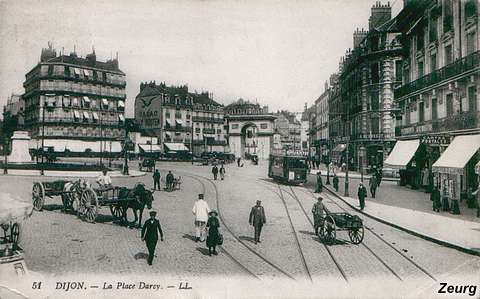
But then I read about the first kitchen Fisher presided over, in Dijon in 1931. It had no running water (which had to be carried in from the landing) or ice box . . . and its stove consisted of two gas burners with a tiny cover that could be fitted over them by way of an oven. My excuse vanished, and I decided to make one of her specialities from that time, for which she gives no rule, just a vague description. But it was enough.
You take a head of cauliflower and split the fleurs apart, in clusters that
are not too small or too large — enough of them to cover the bottom of
a baking pan. Boil them for about three minutes, no longer, drain them
and lay them in the pan. Pour heavy cream over each of the fleurs, enough so
that the cream covers the bottom of the pan to a depth at least halfway
up the sides of the fleurs, and then perhaps a little more if you feel
reckless.

Put a lot of fresh grated Gruyere on top of the fleurs and the cream, enough
to make a somewhat less than solid layer of cheese over the whole
thing, part of it floating, part of it on the fleurs. Then grind fresh
pepper over it all.
Bake it in an oven at maybe 350° (Fisher doesn’t say, because her little oven probably didn’t have a thermostat.) Certainly no lower.
When the top of the thing is toasty brown, take it out. (Fisher wasn’t quite
sure why her little oven browned the top of the dish. It must have been
because enough of the Gruyere stayed on top of the bubbling sauce to
get toasted, and it worked the same way in my toaster oven. In a
real oven you need to place the pan on a high rack to get the same effect.)
Eat it immediately, with some full-bodied red wine of whatever
simplicity. A Cahors would be cool, if you could find it.
Have some good bread to dunk in the strange, rich sauce in which the Gruyere has and has not quite merged with the cream.
This is the meal — barring some salad or desert afterwards, if you care about those things.
When you eat this meal, the word elegant will not spring to mind. The words perfection, miraculous and inspiring will.
First of all you will have a connection with certain evenings in Fisher’s long-vanished life in Dijon — a connection which can only be described as complex. It makes you feel sad and hopeful, all at once.
Second, you will never think about cauliflower again in quite the same way — and I say this as someone who almost never thinks about cauliflower at all.
Third, you will discover a new aspect to the complicated personality of
Gruyere. As with French onion soup, its flavor will make you feel like
a virtuous old peasant. In this dish, it will make you feel like a
virtuous old peasant whose kindness has touched the lives of heroes and
saints. (This is the inspiring part.)
I am perhaps diluting the absolute virtue of the experience by sharing it here, but really, how can I keep quiet about a thing like this? Any more than Fisher could?
THE BELLBOY
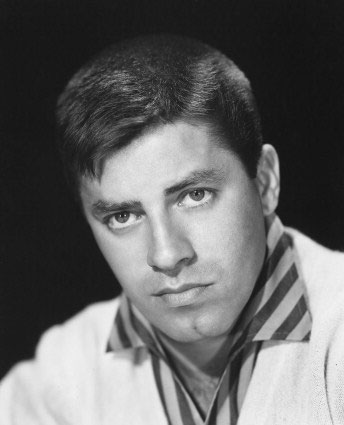
It’s impossible to categorize Jerry Lewis’s movies, and that’s why it’s
always been hard for critics to appreciate him — or even to see his
work for what it is. It has roots in vaudeville and silent film and
circus clowning, and owes much to the antic, animation-inspired cinema of Frank
Tashlin, who directed some of Lewis’s early films, but the influences
are all mixed up in an eccentric blend that has no obvious continuity with any cinematic tradition. He was a genuine radical whose popularity kept his films free from the
controls of corporate Hollywood and gave him the opportunity to follow
his instincts wherever they happened to lead him. There’s a
resulting lack of discipline in his movies that makes them disconcerting on an
intellectual, aesthetic level — unless, like the French, you find
their conceptual incoherence intellectually and aesthetically
satisfying.
The Bellboy, the first film he directed, remains
unsettling a quarter century after it was made. It embodies a unique
sensibility unmodulated by the cinematic conventions of its day, or
ours. It’s best viewed and enjoyed as a critique of those conventions,
spiced with moments of hilarious visual and verbal comedy — and as the
debut of the most original provocateur ever to function within the nominal
boundaries of the Hollywood mainstream.
WALT AND SKEEZIX
It’s an exciting time for fans of the classic American comic strip. A few small, quality-minded publishing houses are issuing handsome new reprints of some of the glories of the genre — including, from Drawn and Quarterly Press, the start of a complete run of Frank King’s masterpiece Gasoline Alley. Volume two has just appeared, continuing the adventures of Walt, a genial car nut, and bachelor, who one days finds an infant on his doorstep and decides to keep and raise him.
King began his domestic epic in the 1920s (the strip premiered in 1918 but the kid didn’t appear at Walt’s door for a couple of years) and kept it going into the 1950s (when he turned it over to other artists), allowing us to watch the child, named Skeezix, grow up in real time. The strips of the early years constitute a sweet, sharply-observed paean to single parenthood and, more importantly, a deeply-felt celebration of the joys of fatherhood without equal in American art.
The strips have been unavailable for years, and never presented in complete form — check them out and cherish a rare treasure from our culture’s not-so-distant past.
HAROLD LLOYD

The recent Harold Lloyd box set is both a miraculous treasure and a
daunting challenge.
Like most people of a certain age I got to know the work of Chaplin and
Keaton slowly, in bits and pieces, over the course of many years,
starting with the 8mm Blackhawk versions of the Chaplin Mutuals my
friends and I collected in high school, continuing through occasional
college campus screenings and the theatrical reissues of the 60s and
70s.
This gave one time to absorb the bewildering genius of these two great
artists.
Lloyd’s most important films were much harder, in many cases
impossible, to find. Before the release of the Lloyd box set I think
I’d only seen Haunted Spooks and Safety Last — enough to know that
Lloyd was a force to be reckoned with but hardly enough to appreciate
the full measure of his achievement.
Now, getting so much of Lloyd’s work all at once, in the fine transfers
on the new set, I find myself a bit overwhelmed — it’s really too much
to react to in detail — but my first impressions of it go something
like this . . .
Having watched each film in the set at least
once, it’s clear to me that Lloyd was not only a filmmaker of equal rank with
Chaplin and Keaton, but of equal rank with any filmmaker in the history
of movies. With such an artist, it makes almost no sense to
compare and contrast him point for point with his peers — one loves
him for his unique genius.
The center of that genius was Lloyd’s instinctive love for and
understanding of the film medium. He didn’t comment on it as part of
his method, the way Keaton did, but he used it with unabashed joy and
energy, and with a supreme mastery that’s still dazzling.
There is hardly any film in the new set that doesn’t have its
exhilarating moments, though this is not to say that all the films
succeed equally as unified works. What distinguishes one from the
other is a central problem Lloyd seemed to wrestle with creatively
throughout his career — the nature of the character he’s playing and
its place in the particular story he’s telling.
The “glasses character” is an everyman in the sense that he presents
himself, whether rich or poor, urban or rural, as a fellow of ordinary
capacities who is impelled at some point to do extraordinary things.
These “extraordinary things” were clearly what inspired Lloyd the
filmmaker most centrally. He usually thought up the final chase or
thrill climax for his films first, and then worked backwards to create
a narrative rationale for the action in that last reel.
Lloyd’s last reels are almost always brilliant — the narrative rationales vary greatly in kind and quality and determine the success or failure of the films as stories, as whole works.
As a general rule I would say that the films in which the glass
character is motivated primarily by a desire for success, financial or
social, are the least satisfying, even when that desire for success is
linked to the character’s desire to win the approval of a girl. These
films of course reflected the values of a different time, the Roaring
Twenties, in which unbridled material ambition was seen as a primary
American virtue, but the attitude struck even some observers of the
time as shallow and disturbing, and it hasn’t aged well.
The “romantic” premise of both Safety Last and Girl Shy is that the
glass character must achieve financial success in order to win the hand
of his beloved. This tends to undercut the “romance” angle
considerably — can’t true love rise above a concern for cold hard
cash? — and turns the “hero’s journey” into the hustler’s
progress. (In these films we see the genesis of James Agee’s brilliant
observation about Lloyd — he “wore glasses, smiled a great deal, and
looked like the sort of eager young man who might have quit divinity
school to hustle brushes.”) The last reels of both these films are so
exciting cinematically that we hardly remember what got us to them, but
the excitement is curiously unemotional, like a ride on a
roller-coaster.
Similarly, the desire of the freshman in the film of that name to be
liked by people who are frankly presented as jerks strikes an odd
note. Lloyd knew that social embarrassment, and even social
humiliation, are good material for gags, but how can one be seriously
embarrassed or humiliated by jerks unless one is a bit of a jerk
oneself? At best this tends to undercut our sympathy for the freshman
— at worst it puts us squarely in the camp of the jerks who are laughing at him,
too. The emotional set-up is off-kilter in The Freshman, as is the
emotional pay-off. We’re told that the protagonist needs to be
himself, stop trying to gain his self-esteem from the opinions of
others — but then he impersonates a football player and achieves
spectacular success on the field as thousands cheer. The episode is
wonderful, hilarious, magical even — but it doesn’t jibe emotionally
or thematically with the rest of the film.
I would argue that Lloyd’s greatest films, his masterpieces, are the
ones in which the glass character has something more interior to do
than gain wealth or status — who has some inner weakness or
selfishness to overcome before he can win the day and be worthy of his
girl.
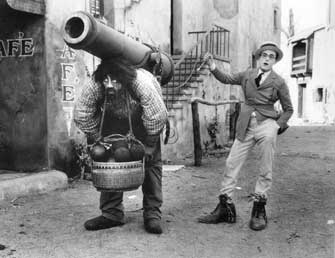
These masterpieces would include Why Worry? and For Heaven’s Sake,
in both of which Lloyd plays a character who’s already rich but lacks
inner grit and empathy until spurred on to them by the leading lady.
They would include The Kid Brother, in which the protagonist needs to
grow up and establish his own identity in the face of obstacles both
domestic and foreign. None of these films has a last reel as awesome
as the ones mentioned above, but they’re awesome enough, and to me more
satisfying, because they reflect deeper emotional transformations in
the film’s central characters.
Because the glasses character isn’t a clown, doesn’t have a clown persona
that migrates more or less intact from film to film, Lloyd always had
to ask who his protagonist was, what he wanted, this time out. The
nature of the answers he came up with ultimately determined the overall
quality of the films as satisfying stories, as unified works of art.
Watching the business on the building in Safety Last or the
race-to-the-rescue to end all races-to-the-rescue in Girl Shy, you won’t be troubled with
such reflections — they become, for the moment, quite irrelevant. But the
next time you come back to the films — and Lloyd’s films are films
that can be watched with profit over and over again, if only for their
sublime cinematic inventiveness — you may feel differently, and long
for the more modest but more moving pleasures of Why Worry?, For
Heaven’s Sake and The Kid Brother.
THE CONQUEST OF MEXICO
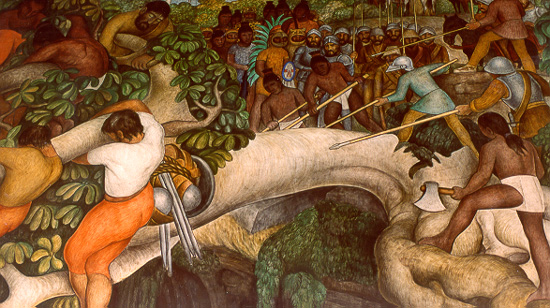
The great historians of the 19th Century established
the practice of history as a science, one which had to be founded on a
massive, exhaustive research into primary sources. The industry they
displayed in this pursuit, given the difficulties of travel and
communication in their time (not to mention the lack of photocopying
machines), is almost incredible.
But their devotion to documented facts did not divert
them from their duties as storytellers and moral guides. They felt
perfectly free to interpolate fanciful speculations into their texts,
often in the guise of exposing them as such, and to share their
personal opinions about any subject that came under their eyes —
revealing nationalistic, religious and racial prejudices which later
generations of historians would shudder to confess.
And they always kept in mind their duty to literature
as well, their obligation to write in learned but entertaining prose
that could be comprehended with ease, as well as with pleasure, by any
educated person.
The general result is that these 19th-Century
historians are a hoot to read — and none is more of a hoot than
William H. Prescott, of Boston, whose History Of the Conquest Of
Mexico, from 1843, while still accepted, with reservations, as a
pioneering work of history, is almost universally admired as a work of art.

The voice of the writer is confidential but assured,
as he mocks his less rigorous peers, pronounces moral judgments on
whole civilizations, damns the scoundrels and praises the heroes who
people his epic, and parades his learning with circumspect but
unmistakable pride. He allows himself to be known.
Modern historical practice finds this sort of personal
interjection deplorable, but it might be argued that it has its own
corrective built into it. A frank confession of prejudice on the part
of a historian makes it easier to form our own judgment of his or her
conclusions than a pretense of absolute objectivity which we know is
quite beyond human achievement.
Be that as it may, William Prescott is good company,
and his great history of Cortes and the subjugation of the Aztecs fires
the imagination in such a way as to impress the results of its vast
erudition on the mind indelibly. We can correct his bias by consulting
later, more “disinterested” historians of the events in question — but
they will never make us care about them the way Prescott does.
VITORIO STORARO
When Bernardo Bertolucci and his cinematographer
Vitorio Storaro began preparing The Conformist, Storaro suggested a
visual style that would emphasize bold contrasts between light and
shadow, to reflect the conflicted nature of the film’s protagonist. He
said he thought immediately of the painting above by Caravaggio, with
its strange, not quite naturalistic lighting scheme, and tried whenever
possible to introduce similar hard edges between the dark and light
areas of his images in The Conformist.
In general, Bertolucci’s films draw on effects from painting, especially
from painting that has marked stereometric qualities. Many of the
beautiful compositions involving the urban spaces of Paris in The
Conformist seem to reference the urban landscapes of Caillebotte, an
Impressionist who incorporated the spatial dramatics of academic
painting into his work to a far greater degree than his peers in the
Impressionist movement.
Much of 1900 seems to reference the treatment of pastoral scenes in
19th-Century academic painting.
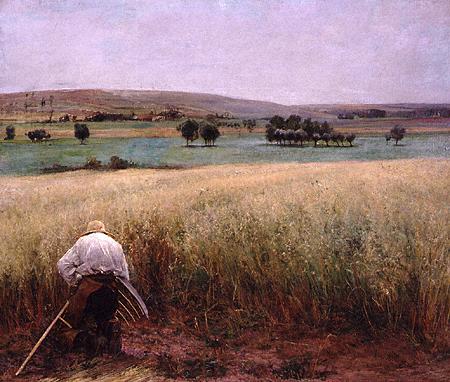
It’s hard to know how conscious the references to
19th-Century academic painting were for Bertolucci and Storaro, since
this influence had already been absorbed in the visual styles of the
great silent filmmakers like Griffith and Vidor and Murnau, who in turn
clearly influenced Bertolucci. Bertolucci
and Storaro might have tapped into the tradition at any point along the
line of its transmission. But Storaro has made clear his
indebtedness to Caravaggio, and that should lead us logically into an
investigation of other painterly influences on his work, especially his
work for Bertolucci.
I’m not sure how much such an investigation contributes to the experience
of the films, since these sorts of visual strategies and references must
work first on a subliminal level if they are to be genuinely effective,
but it’s certainly fascinating . . . and perhaps of use to other
filmmakers.
FROM POE TO BAUDELAIRE TO CHAPLIN
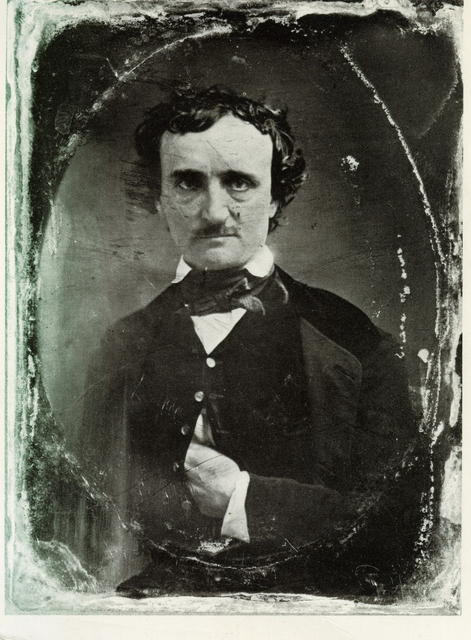
Here’s Walter Benjamin on Poe’s description of “the crowd” — an image
of great importance to Baudelaire:
“We may assume that the crowd as it appears in Poe, with its abrupt and
intermittent movements, is described quite realistically. In itself,
the description has a higher truth. These are less the movements of
people going about their business than the movements of the machines
they operate. With uncanny foresight, Poe seems to have modeled the
gestures and reactions of the crowd on the rhythm of these machines.
The flaneur, at any rate, has no part in such behavior. Instead, he
forms an obstacle in its path. His nonchalance would therefore be
nothing other than an unconscious protest against the tempo of the
production process.”
The Parisian flaneur was a type of 19th-Century dandy whose pleasure it
was to wander, and to be seen to wander, the boulevards with no
apparent purpose. This pose was a conscious endorsement of pure
sensibility over practical endeavor and, as Benjamin suggests, perhaps
an unconscious protest against an increasingly mechanized and
regimented industrial society.
Chaplin’s Little Fellow is a flaneur. His dandyism has become a bit
shabby but abides in his fastidiousness about his dress and its
pretension to style — well-exemplified in the Tramp’s delicacy in
removing and replacing the detached finger of his glove in one of the
opening sequences of City Lights. The pretension involved is not
about class, but about dignity. Like a true flaneur, the Tramp wanders
through the world in a state of detachment from it, observing,
sometimes mocking, sometimes hustling what he wants from it, but never
seeking its endorsement. Another remark by Benjamin on Baudelaire is
relevant here:
“Baudelaire was obliged to lay claim to the dignity of the poet in a
society that had no more dignity of any kind to confer. Hence the
bouffonnerie of his public appearances.”
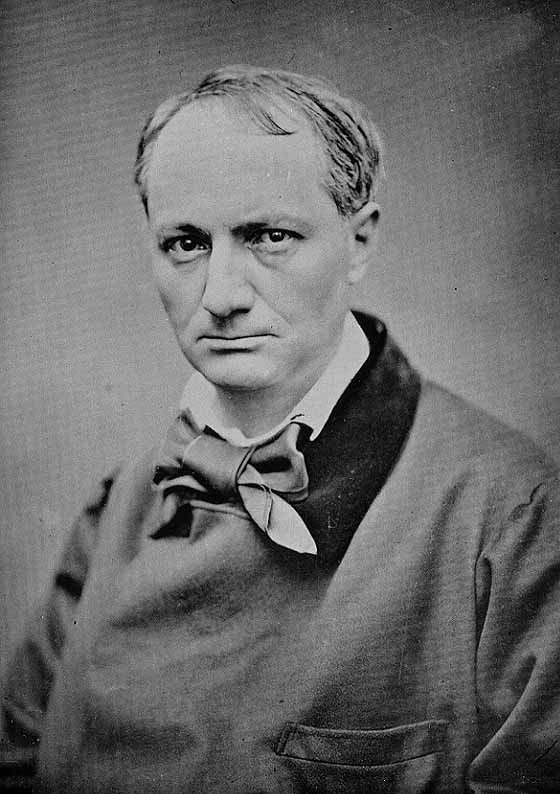
Chaplin’s flaneur, like Baudelaire’s scandalous poet, had to be a comic
figure in the context of his time — his insistence on dignity in an
undignified world had to be ironical. But it is still sincere, and
heroic. The buffoonery of Baudelaire and the Tramp becomes an
accusation, and the dignity they insist on is real, if absurd in the
context of their times.
In Modern Times the flaneur is diverted from his strolling about and,
inside the factory, his movements become subsumed by the movements of
the machines, which eventually overpower and consume him. Contrast
this with Buster Keaton’s battle against a mechanized universe. Keaton
becomes a kind of uber-machine — a machine with soul and purpose and
courage, more intricate and ingenious and lyrical than the machines
he’s fighting. He bests the machines on their own terms and in that
way restores the primacy and the dignity of the human being.
But the flaneur doesn’t have this capacity, or this option. His
triumph is just to wander on, dusting the dirt off his tattered finery,
setting his hat at a rakish angle, flexing his cane, untouched by the
more profound shabbiness of the world around him — a hero not of deeds
but of example.
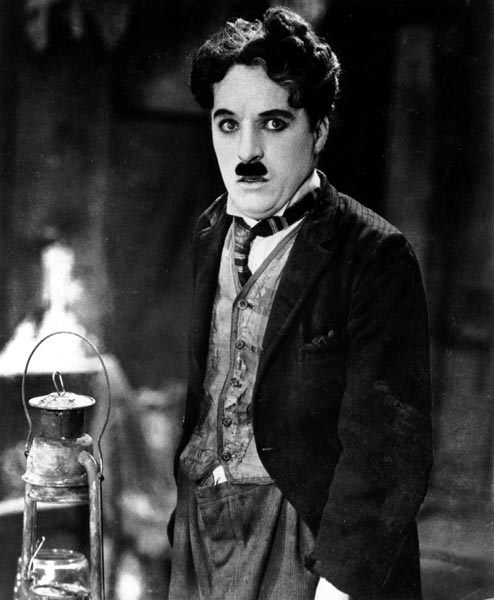
THE WIDESCREEN MUSEUM
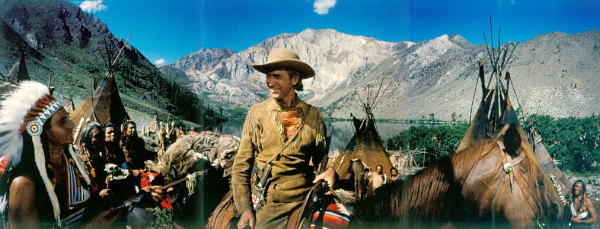
This is one of the great film websites — informative and entertaining, devoted to all varieties of widescreen movie formats:
THE OYSTER PRINCESS
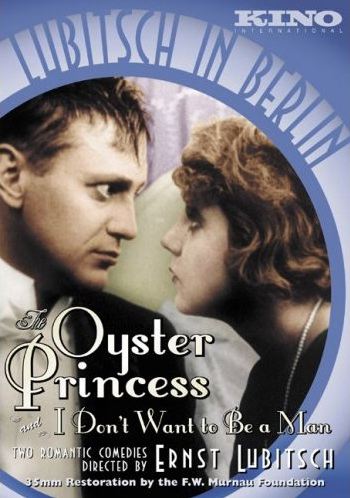
The first thing to be said about The Oyster Princess, from 1919, one
of the films recently released in Kino's “Lubitsch In Berlin” series, is
that there's little evidence in it of “the Lubitsch touch” — that
gossamer comedy of suggestion and indirection that came to characterize
the director's mature style.
The Oyster Princess is very broad farce, verging on slapstick at
times. That said, though, the film, for all its aggressive silliness,
has remarkable stylistic assurance and consistency — it's witty,
charming and often very funny. What it resembles most closely are the
operettas of Offenbach, or rather of his librettists Henri Meilhac and
Ludovic Halevy, which manage to combine delirious frivolity with an edgy
satire of aristocratic pretensions. The style is frothy and subversive
at the same time.
The Oyster Princess has a preposterous plot, involving a marriage
under false pretenses, and equally preposterous depictions of
aristocratic dementia that often veer into the realms of the surreal.
(In some ways they are lighter-hearted versions of Von Stroheim's dark
and grotesque portrayals of these same aristocratic circles.) But
there's more to it than that, just as there's more to Offenbach than his
farcical plots — there's Lubitsch's extraordinary cinematic
imagination, which at times causes the film to soar into the same
ethereal realms that Offenbach's music inhabits.
The wedding scene, for example, involves the sublime choreography of an
army of servants in action, and an even more delirious set-piece in
which the guests, and even the servants, break out in an hysterical
episode of fox-trotting — travesties of actual behavior organized with
exhilarating plastic grace. The film transcends itself in these
moments, just as Offenbach's melodies transcend their dramatic vehicles.
So if “the Lubitsch touch” isn't on display here, except in a few stray
scenes, the Lubitsch genius explodes often enough to make us realize we
are in the company of a master of the medium, even if he's a master
still in search of a distinctive personal style.
BEYOND COOL
Some toys just are. Above is the Sideshow 12-inch action figure of Lon Chaney in his Masque Of the Red Death costume from The Phantom Of the Opera. I still can’t quite believe that somebody made this extraordinary thing, and that I own one.
BABY FACE
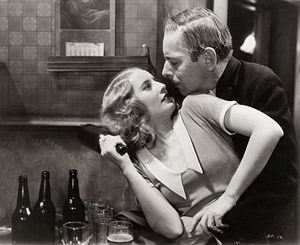
In the days before its Production Code got really strict (around 1934)
Hollywood had extraordinary latitude in the subjects and attitudes it
could address. Turner Classic Movies has just released a set of three
pre-code films, under the title Forbidden Hollywood, that gives some
startling examples of the freedom that was lost.
Baby Face, starring Barbara Stanwyck, presents a world-view of
jaw-dropping cynicism — a case study of bimbo feminism that would be
shocking even in a Hollywood film of today. Stanwyck plays Lily, a
girl who’s been hooking since she was 14, pimped out by her own
father. She meets an eccentric Nieztsche fan who tells her to use her
power over men ruthlessly, without sentiment or conscience, to get what
she wants. And this she does — fucking her way to the big city, and
up the ladder of success, until she’s the filthy rich mistress of a
pathetic old banker.
The passion and jealousy Lily arouses in the men she uses eventually erupt in violence, and set up a nifty blackmail opportunity for her, but also throw her into the orbit of a different sort of man than she’s used to, a man who knows all about her past but loves her anyway . . . and she finds a kind of redemption in his arms.
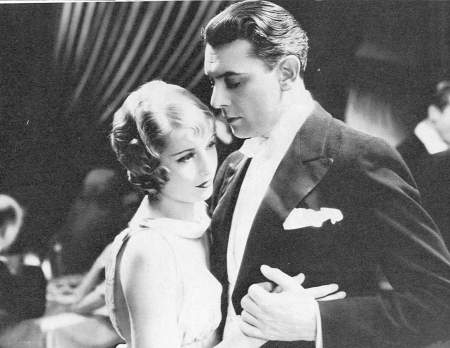
All the men Lily encounters, except for the last one, are slimeballs
and pushovers, and Lily never shows even a flicker of remorse about
exploiting them and destroying them. The really shocking thing is
that the film doesn’t condemn her for this, any more than her last lover
does — she’s been dealt a bad hand in life, as a woman, and she’s
played it the best way she could.
This is all dizzyingly surreal. Seeing Hollywood stars and Hollywood
production values deployed in the service of a story like this makes
one feel one has entered an alternate universe — except of course that
it’s closer to the universe we actually inhabit than to the post-code
Hollywood version of reality.
Baby Face is lurid pulp melodrama at its most entertaining, and it’s
something more, too — a vision of what movies might have been if
corporate hypocrisy and totalitarian concepts of social hygiene hadn’t
put them in an artistic straightjacket.
Rush out and get this set, and prepare to be seriously discombobulated.

